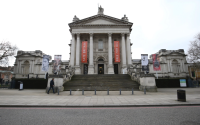Laser Mapping Technology Reveals 2,500-Year–Old Cities Hidden in the Amazon
New laser-mapping technology has uncovered a series of interconnected cities in the Amazon rainforest, according to a study published Thursday in the academic journal Science .
The cities, located in the Upano Valley in Ecuador, near the Andes mountains, were discovered after Ecuador’s National Institute for Cultural Heritage (INPC) launched a survey in 2015, deploying planes equipped with light detection and ranging (LIDAR) technology to reveal topography hidden within the dense rainforest.
While archaeologists from France’s National Center for Scientific Research (CNRS) had also been excavating in the valley for close to 30 years, they had focused on the Sangay and Kilamope settlements. Carbon-dating of various artifacts from those settlements show they had been inhabited from 500 B.C.E. to around 300-600 C.E., around the same time period as the Roman Empire.
The INPC’s LIDAR analysis, however, revealed an additional five major settlements and ten minor ones that included agricultural fields, hillside terraces for crops, drainage canals, interconnected roads, and residential and ceremonial structures built on 6,000 earthen mounds.
“It was a lost valley of cities,” Stéphen Rostain, an archaeologist at CNRS and a co-author of the study, told the Guardian. “It’s incredible.”
The discoveries upend historical understandings of civilization in the Amazon: the largest city in the network is comparable in size to the Giza Plateau in Egypt or Teotihuacán in Mexico, according to Fernando Mejía, an archaeologist at the Pontifical Catholic University of Ecuador.
There is still much to uncover about how complex the Upano Valley societies were, but the initial results appear promising.
“We’re just beginning to understand how these cities were functioning,” Carla Jaimes Betancourt, an anthropology professor focusing on the southwest Amazon at the University of Bonn, told Science.
Little is known about the cities’ population sizes, their trade routes, their governing structures, or other hallmark measures of a society. Antoine Dorison, a study co-author at CNRS, estimated the population was somewhere between 10,000 and 30,000 people at its peak.



